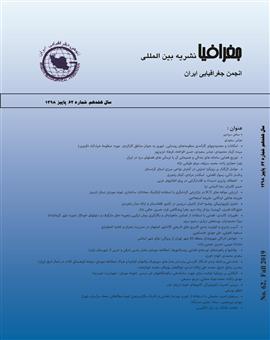تحليل آسيب پذيري و اولويت بندي کاربري هاي تاريخي کلانشهر اصفهان در مديريت بحران و تخليه اضطراري
محورهای موضوعی :علی جوزی خمسلویی 1 , مسعود تقوایی 2
1 -
2 - دانشگاه اصفهان
کلید واژه: آسیب پذيری, شاخصهای بنيادین, شاخصهای مديريتی, تخليه اضطراری, کاربری تاريخی,
چکیده مقاله :
مديريت و برنامه ريزی بحران با تأکيد بر رويکردهای کليدی از قبيل امدادرسانی و تخليه اضطراری در کاربری های شهری اهميت و ضرورت بسياری دارد. در کلانشهر اصفهان اين ضرورت در کاربری های تاريخی اين شهری به وضوح ديده می شود. تمرکز کاربری های تاريخی در مناطق مرکزی اصفهان در کنار عواملی مانند دسترسی نامناسب، معابر تنگ و باريک، عدم تناسب فضایی، ناسازگاری در ساختار، فرسايش تدریجی بنا و فقدان برنامه ريزی مدون در اين کاربری ها موجب گرديده تا کاربری های تاريخی شهر اصفهان در بحران های احتمالی آسیب پذير باشد. روش تحقيق در پژوهش حاضر از نوع اسنادی، تحليلی- پيمايشی و نوع آن بنيادی- کاربردی است. پژوهش حاضردر صدد است تا با تأکيد بر روش مشاهده ميدانی، تکميل چک لیست و مدل سلسله مراتبی AHP به تحليل آسیب پذيری کاربری ها و اولويت بندی آنها در عمليات تخليه اضطراری بپردازد. اساس مطالعه بر مبنای دو گروه شاخص بنيادی و مديريتی است. جامعه آماری تحقيق 420 بنای تاريخی شهر اصفهان است که در فهرست آثار ملی کشور به ثبت رسيده اند. نتايج تحقيق نشان می دهد که منطقه سه شهر اصفهان با وزن 49/0 در شاخص های بنيادين و 53/0 در شاخص های مديريتی در صدر مناطق با کاربری های تاريخی آسیب پذير قرار دارد. و در اولويت اول امدادرسانی و تخليه است. مناطق يک، پنج، شش و ساير مناطق در اولويت بعد هستند. شناسايي و طیف بندی بناهای تاريخی بر مبنای درجه و شدت فرسايش، تقويت سازه ها، آموزش عمليات های تخليه و رعايت پدافند غيرعامل در ساختارها از راهبردهای کلان در مديريت بحران اين کاربری هاست.
Crisis Management and planning based on critical issues as rescue and emergency evacuation in urban land uses is very important. This approach in Isfahan is necessary. Concentration of heritage land uses in central area of Isfahan along with Factors such as inadequate access, narrow streets and alleys, spatial incompatibility, structural maladaptation, gradual erosion of the building and lack of systematic planning in heritage spaces has been caused the historical land uses of Isfahan to be vulnerable in potential disaster. Method of research in the paper is descriptive and analysis- survey and its type is fundamental and practice. The research with emphasis on field work, check list and AHP model is trying to analysis of vulnerability of heritage land uses and their prioritization in emergency evacuation. Structure of research has been established on Basic Indicators, Management criteria. The case study is 420 heritage building of Isfahan the documented in national list. Results that showed Isfahan third district is very vulnerable and in the first priority of evacuation and rescue based on 0.49 weight in basic indicators and 0.53 weight in management ones. First, fifth, sixth and other urban district of Isfahan are in next stages. Identification and classification of monument based on degree and severity of destruction, reinforcement of buildings, training of evacuation operations and civil defense in land use are major strategies in disaster management of these land uses.
